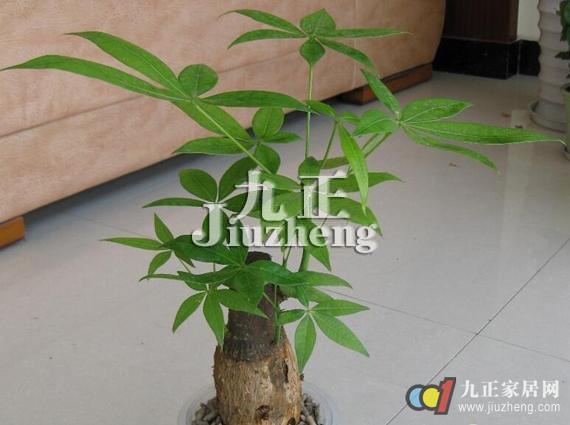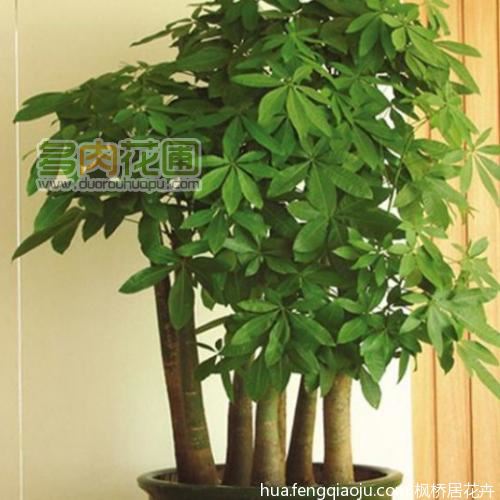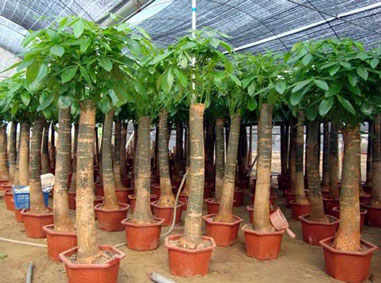How do rich trees reproduce?
The rich tree, also known as Malabasu, is a small tropical evergreen tree of the kapok family, native to Central America and Mexico. Sex likes warmth, the original fruit tree is cultivated, but the blossom and fruit is unstable, it is mainly used as green ornamental plant in our country, sunny, drought-tolerant. Its shade tolerance is also very strong, so it is a good indoor ornamental plant. The plant has strong plasticity and can be cultivated in different shapes according to the needs, such as single head, braided type, mini type, bonsai type and so on.
The rich tree is mainly propagated by sowing, and the mature seeds should be sown within 2 days. The suitable germination temperature is 22-26 ℃, and germinates 3-4 days after sowing. After 12 months, the seedlings were selected according to the height of the plant to produce braided wealth trees with different heights (60cm to 150cm). After editing, select loam with deep soil quality and good drainage, and you can mix some barnyard manure when planting. Topdressing once every 2-3 months after planting.
The suitable temperature for the growth of rich trees is 20: 30 ℃, and the low temperature below 10 ℃ is easy to cause defoliation, so it is more suitable to be planted in Hainan and Zhanjiang, Guangdong, and can be popularized as a water-saving agricultural project. Generally, it can be harvested after planting for 1-2 years. The branches and leaves were cut off during harvest, and the storage and transportation temperature was 15 ℃ in winter and spring and 20 ℃ in summer and autumn. The rich trees harvested are semi-finished products and need to be planted in pots and grow branches and leaves again before they can be put on the market for sale.
The Propagation method of Rich Tree Propagation, maintenance and Management of Wealth Tree
Fortune tree is very popular because of its indomitable vitality, unique ornamental value, and auspicious name. Next, I will share with you the breeding method and maintenance management of fortune tree.
The breeding method of the rich tree:
The propagation methods of rich trees are generally divided into three types: sowing propagation, cutting propagation and grafting propagation.
1. Sowing and propagation of rich trees
The sowing and propagation of rich tree is one of the most common and simple propagation methods. The reasons for sowing and propagation are: neat sowing seedlings, straight roots and smooth seedlings, large seedling emergence, thick "radish head" shape in the lower part, and improve ornamental value.

2. Cutting propagation of rich trees.
The cutting propagation of the rich tree can be carried out all the year round in the south and from May to August in the north. The top tips and branches will be cut into 10cm and 15cm and inserted into the coarse sand, but the base is not inflated and not straight. The rich tree grows rapidly, and after a period of growth, it often causes the branches to grow too long, which affects the ornamental effect. Generally speaking, the overlong branches can be cut at any time during the growth period, or they can be cut short in combination with cutting propagation in spring to maintain a good plant shape. The cutting propagation of the rich tree is easy to survive, but after the seedling grows up, the rhizome will not become thicker and inflated, and the ornamental value is poor, so it is rarely used.
3. Grafting and propagation of rich trees
Rich trees generally blossom and bear fruit 8 years after sowing, and if they want to blossom and bear fruit ahead of time, two-year-old braided seedlings can be selected as rootstocks, and scions can be selected from one-year-old sturdy branches on evaluated flowering trees. In mid-late February, the split method was adopted, and the survival rate reached 80%. The rich tree blossoms in the second year after grafting, but it can blossom and bear fruit five years ahead of schedule.
Reproduction, maintenance and management of rich trees:
The rich tree is not strict with the light and can adapt to the strong sunshine or low light room, so it is best to cultivate it in the shade shed. During the peak growth period, apply 1cm to 2cm thick rotten cake fertilizer in each pot and cover it with 1cm thick culture. Proper application of multi-component compound fertilizer and phosphorus and potassium fertilizer is beneficial to the expansion of dry base. More hardy, watering would rather be dry than wet. The high temperature and humidity in summer are very beneficial to the rich tree, and it is the fastest growing period. In winter, not less than 5 ℃, it is best to keep 18-20 ℃. Medium amount of water in the growing season, less watering in winter, dry and wet, often spray water to the leaves to keep moist, can grow strong.
How to reproduce the rich tree and the breeding method of the rich tree
Rich tree is a kind of potted indoor stem and leaf plant. It is artificially processed into three or five braids, which has high ornamental value. Rich trees are generally produced in the south, while relatively few in the north, so the editor provides you with a set of sand culture method of softwood cuttings, so that the rich trees can be planted successfully in the north. The following editor would like to introduce you:
1. Seedbed finishing
Select a deep and fertile nursery, adjust it into a border surface 1 meter wide, the length depends on the number, and it is appropriate to move from north to south, turn the border surface deeply, remove the topsoil, smash it, and lay a layer of gravel 3 cm thick in the lower layer. 10 to 15 cm thick fresh river sand and slag are spread on the top, and the humidity is held by hand, and it is appropriate to let go. Spray the bed with 40% formalin 400 times, with a depth of 3 to 5 cm, cover with plastic film for 3 days, and disinfect the soil.
two。 Cutter collection
Select strong-growing semi-lignified branches and cut them in cloudy or windless morning. the length of the cut is 6 to 7 cm. The lower incision is inclined, located under the leaf or axillary bud, and the incision should be smooth, which is conducive to the formation of healing tissue. Generally each cuttings with two palm leaves, be careful not to hurt the leaves, in order to facilitate photosynthesis.
3. Fine cuttage
The rich tree is cut from late June to early August and should be cut on a cloudy day in summer or in the morning and evening. When cutting, put 1/2 of the cuttings in 25m (I) ABT rooting solution, soak for 20 to 24 hours, remove and rinse with clean water. Punch holes in the border with a small stick, then insert the cuttings along the holes, and then seal the holes and compact them. Cuttings can be cut straight for a short time, and cuttings can be cut obliquely when they are longer. The depth of cuttings shall prevail without skew, generally 3 to 5 cm. Water thoroughly in time after cutting, straighten the incorrect cuttings, and cover them with plastic sheeting.
4. Seedling stage management
Ventilation every 3 days after cutting, high temperature from June to August, rapid evaporation of water, spray water in the morning and evening, the temperature is kept between 23 and 25 degrees, and the humidity is about 80% of the field capacity. In order to promote the Lignification of seedlings, 0.2% potassium dihydrogen phosphate can be sprayed before the end of August. In order to prevent fungal infection, methyl topiramate or carbendazim is sprayed on the border every 7 days. Generally, calli were produced in about 15 days, and began to take root in about 30 days.
5. Seedling transplanting
Nutritious soil should be prepared before the seedlings are put on the pot. 3 parts of rotten leaf soil, 1 part of sand and 2 parts of garden soil should be mixed and planted. When transplanting, we should pay attention not to hurt the root, the depth is based on the base of the original root, pour water thoroughly after planting, put it in the shade, avoid the sun exposure, and water the pot soil every day according to the situation of potted soil.
The above Xiaobian provides you with the breeding method of the rich tree, which has the advantages of fast reproduction, high survival rate, time-saving and labor-saving. I hope you can take action and try it as soon as possible.
- Prev

What are the matters needing attention in the cultivation and maintenance of rich trees?
The rich tree, also known as Malaba chestnut, melon chestnut, etc., is an evergreen tree of the kapok family. At first, it was introduced to Taiwan as a fruit tree, but the flowers did not blossom when they were planted intentionally. Inadvertently insert willow but become overcast, as a fruit tree has not been promoted, potted ornamental is very popular, and quickly exported to Japan, South Korea
- Next

How to breed and cultivate rich trees?
Fortune tree is a popular indoor potted foliage plant in China in the 1990s, and it is also one of the fashionable foliage flowers. It is suitable for ornamental plant cultivation in offices or halls. Propagation of rich trees, with cuttage law and sowing law can be, with seed propagation of rich trees, stem base hypertrophy
Related
- Fuxing push coffee new agricultural production and marketing class: lack of small-scale processing plants
- Jujube rice field leisure farm deep ploughing Yilan for five years to create a space for organic food and play
- Nongyu Farm-A trial of organic papaya for brave women with advanced technology
- Four points for attention in the prevention and control of diseases and insect pests of edible fungi
- How to add nutrient solution to Edible Fungi
- Is there any good way to control edible fungus mites?
- Open Inoculation Technology of Edible Fungi
- Is there any clever way to use fertilizer for edible fungus in winter?
- What agents are used to kill the pathogens of edible fungi in the mushroom shed?
- Rapid drying of Edible Fungi

